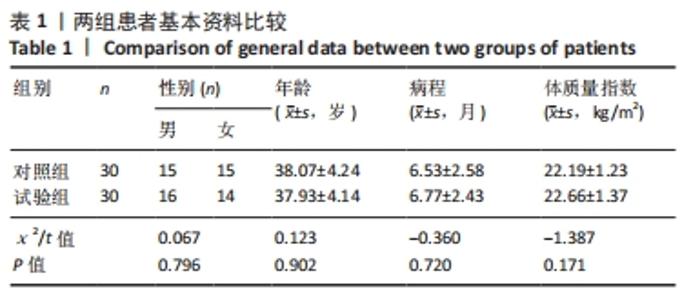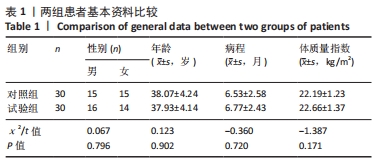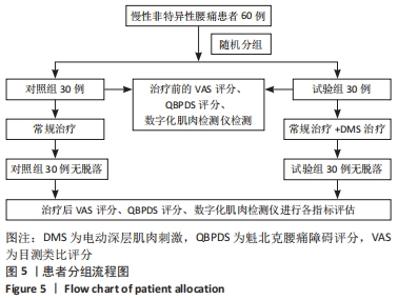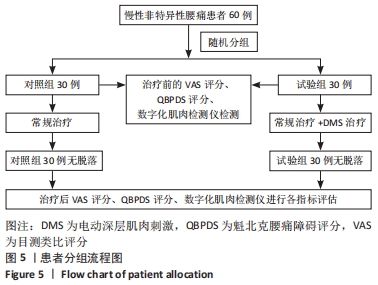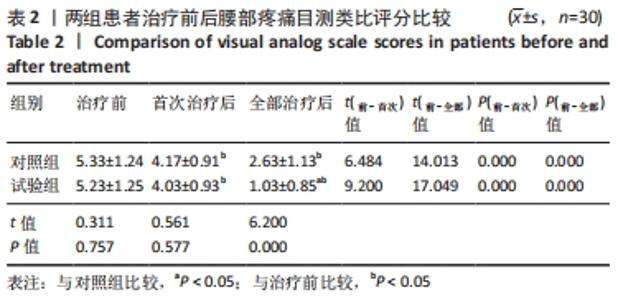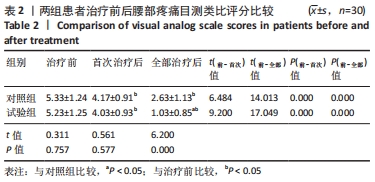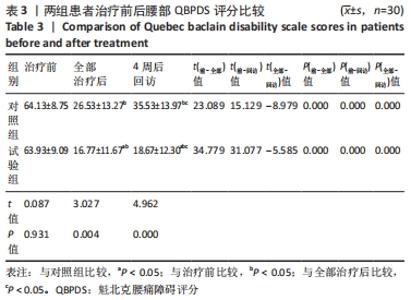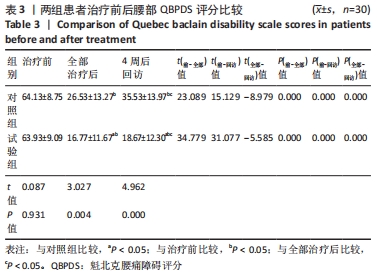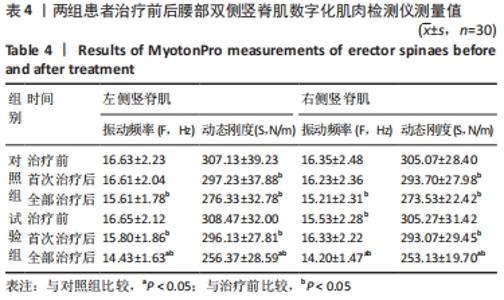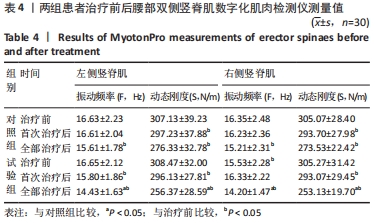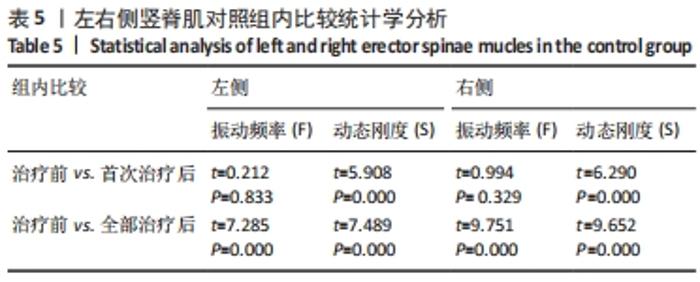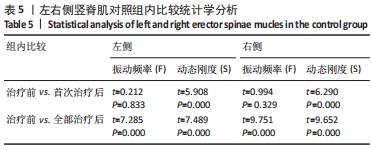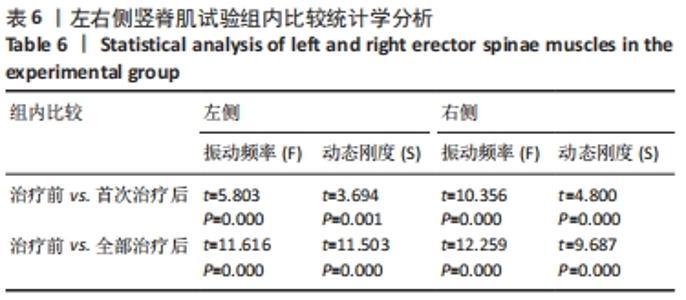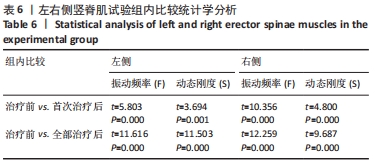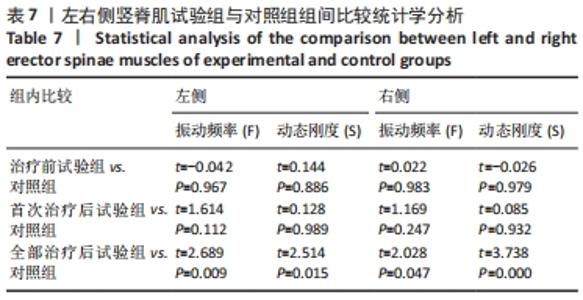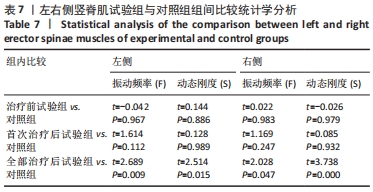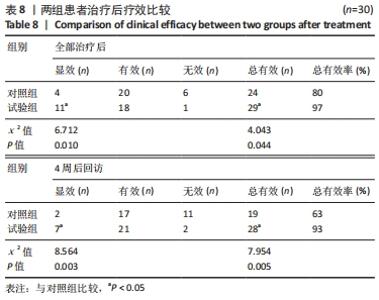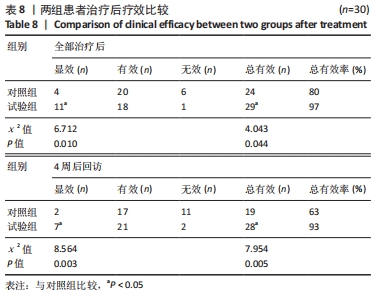Chinese Journal of Tissue Engineering Research ›› 2023, Vol. 27 ›› Issue (8): 1250-1256.doi: 10.12307/2022.1024
Previous Articles Next Articles
Effect of deep muscle stimulation on muscle tone and stiffness of erector spinaes in patients with chronic nonspecific low back pain: a digital muscle testing
Zhang Qiming1, Bao Sairong2, Shan Sharui2, Zhong Zhiliang2, Liu Chunlong1
- 1Clinical Medical College of Acupuncture and Moxibustion Rehabilitation, Guangzhou University of Chinese Medicine, Guangzhou 510000, Guangdong Province, China; 2First Affiliated Hospital of Guangdong Pharmaceutical University, Guangzhou 510000, Guangdong Province, China
-
Received:2022-01-04Accepted:2022-03-10Online:2023-03-18Published:2022-07-27 -
Contact:Liu Chunlong, Professor, Master’s supervisor, Clinical Medical College of Acupuncture and Moxibustion Rehabilitation, Guangzhou University of Chinese Medicine, Guangzhou 510000, Guangdong Province, China -
About author:Zhang Qiming, Therapist-in-charge, Clinical Medical College of Acupuncture and Moxibustion Rehabilitation, Guangzhou University of Chinese Medicine, Guangzhou 510000, Guangdong Province, China -
Supported by:Guangdong Young Innovative Talents Project, No. 2017KQNCX109 (to SSR); The Education and Teaching Research and Reform Project of the First Affiliated Hospital of Guangdong Pharmaceutical University, No. 2020JX06 (to SSR)
CLC Number:
Cite this article
Zhang Qiming, Bao Sairong, Shan Sharui, Zhong Zhiliang, Liu Chunlong. Effect of deep muscle stimulation on muscle tone and stiffness of erector spinaes in patients with chronic nonspecific low back pain: a digital muscle testing[J]. Chinese Journal of Tissue Engineering Research, 2023, 27(8): 1250-1256.
share this article
Add to citation manager EndNote|Reference Manager|ProCite|BibTeX|RefWorks
| [1] JOUD A,PETERSSON IF, ENGLAND M,et al. Low back pain:epidemiology of consultations.Arthritis Care Res. 2012;64(7):1084-1088. [2] FURTADO RN, RIBEIRO LH, ABDO BA, et al. Nonspecific low back pain in young adults: associated risk factors. Rev Bras Reumatol. 2014;54(5): 371-377. [3] TYMECKA-WOSZCZEROWICZ A, WRONA W, KOWALSKI PM,et al. Indirect COSTS of back pain-Review. Polis Hannals Med. 2015;22:143-148. [4] COULOMBE BJ, GAMES KE, NEIL ER, et al. Core Stability Exercise Versus General Exercise for Chronic Low Back Pain. J Athl Train. 2017;52(1): 71-72. [5] 中国康复医学会脊柱脊髓专业委员会专家组.中国急/慢性非特异性腰背痛诊疗专家共识[J].中国脊柱脊髓杂志,2016,26(12):1134-1138. [6] MASAKI M, AOYAMA T, MURAKAMI T, et al. Association of low back pain with muscle stiffness and muscle mass of the lumbar back muscles, and sagittal spinal alignment in young and middle- aged medical workers. Clin Biomech (Bristol, Avon). 2017;49:128-133. [7] KOPPENHAVER S, GAFFNEY E, OATES A, et al. Lumbar muscle stiffness is different in individuals with low back pain than asymptomatic controls and is associated with pain and disability, but not common physical examination findings. Musculoskelet Sci Pract. 2020;45:102078. [8] POŻAROWSZCZYK B, PAWLACZYK W, SMOTER M, et al. Effects of karate fights on achilles tendon stiffness measured by myotonometry. J Hum Kinet. 2017;56:93-97. [9] SOHIRAD S, WILSON D, WAUGH C, et al. Feasibility of using a hand-held device to characterize tendon tissue biomechanics. PLoS One. 2017; 12(9):e0184463. [10] CHIAROTTO A, BOERS M, DEYO RA, et al.Core outcome measurement instruments for clinical trials in nonspecific low back pain. Pain. 2018; 159(3):481-495. [11] BIZZINI M, MANNION AF. Reliability of a new, hand-held device for assessing skeletal muscle stiffness. Clin Biomech (Bristol, Avon). 2003; 18(5):459-461. [12] 冯亚男,李亚鹏,张志杰,等. 数字化弹性触诊仪用于健康人竖脊肌硬度评估的研究[J].中国康复医学杂志,2019,34(4):465-467. [13] 吴昌师,夏寿涛,曾珊,等.立体干扰电结合核心肌力训练治疗非特异性下腰痛的疗效观察[J] .当代医学,2021,27(12):106-108. [14] 周先珊,高澍,余芳,等.核心稳定性训练对海勤人员慢性非特异性腰痛的疗效评价[J].颈腰痛杂志,2021,42(5):703-705 [15] 吴琼,潘钰,徐泉,等.健康教育管理模式对慢性非特异腰痛患者疗效的影响[J].中国康复理论与实践,2018,24(1):101-106. [16] 葛瑞东,白硕,郭京伟,等.局部肌肉振动对男性慢性非特异性腰痛患者腰背肌疲劳的即刻效应[J].中国康复医学杂志,2019,34(3):287-292. [17] 鲍赛荣,林利华,单莎瑞,等.电动深层肌肉刺激对脑卒中肱二头肌张力、弹性及硬度影响的研究[J].中国组织工程研究,2021,25(20): 3138-3143. [18] 袁松,高峰,刘飞,等.局部振动疗法对慢性非特异性腰痛的疗效研究[J].中国康复,2018,33(3):234-236. [19] 王雪强,郑依莉,胡浩宇,等.常用腰痛功能障碍评估量表的研究进展[J].中国康复理论与实践,2017,23(6):672-676. [20] MONTICONE M, ARIPPA F, FOTI C, et al.Responsiveness and minimal important change of the Quebec Back Pain Disability Scale in Italian patients with chronic low back pain undergoing multidisciplinary rehabilitation.Eur J Phys Rehabil Med. 2022 Feb 1. doi: 10.23736/S1973-9087.22.07385-3. [21] AGYAPONG-BADU S, WARNER M, SAMUEL D, et al. Measurement of ageing effects on muscle tone and mechanical properties of rectus femoris and biceps brachii in healthy males and females using a novel hand-held myometric device. Arch Gerontol Geriatr. 2016;62:59-67. [22] 郑沛,邢新阳,霍洪峰,等.足外翻肌群激活练习:对拮抗肌弹性、张力及硬度的交互抑制效应[J].中国组织工程研究,2022,26(8): 1149-1153. [23] NAIR K, MASI AT, ANDONIAN BJ, et al. Stiffness of resting lumbar myofascia in healthy young subjects quantified using a handheld myotonometer and concurrently with surface electromyography monitoring. J Bodyw Mov Ther. 2016;20(2):388-396. [24] 曹华.麦肯基手法结合理疗治疗非特异性下腰痛患者50例[J].按摩与康复医学,2019,10(15):5-7. [25] GOUBERT D, OOSTERWIJCK JV, MEEUS M, et al. Structural changes of lumbar muscles in non-specific low back pain: a systematic review. Pain Physician. 2016;19(7):e985-e1000. [26] 李绪,许子琢,鲁俊,等.基于肌张力描记技术测量的慢性非特异性腰痛竖脊肌收缩特性分析[J].中国康复理论与实践,2021,27(4): 450-455. [27] 陈景洲,王惠娟,石真润,等.慢性非特异性腰痛患者躯干肌的等速力学特征和肌电信号研究[J].中国康复医学杂志,2021,36(1):51-56. [28] SANDERSON A, MARTINEZ-VALDES E, HENEGHAN NR, et al. Variation in the spatial dis- tribution of erector spinae activity during a lumbar endurance task in people with low back pain. J Anat. 2019;234(4):532-542. [29] 李霞,郝增明,王晓东,等.慢性非特异性下背痛患者竖脊肌等长收缩时空间活动特征[J].中国运动医学杂志,2021,40(5):338-343. [30] 王琨, 白爱利,李小生,等.不同坐姿下腰部负荷及竖脊肌活动的生物力学研究[J].西安体育学院学报,2008,25(1):67-72. [31] LIMA M, FERREIRA AS, REIS F, et al. Chronic low back pain and back muscle activity during functional tasks. Gait & Posture. 2018;61:250-256. [32] 杨森,武文杰,杜诗宇,等.慢性非特异性下腰痛患者腰背肌力量和耐力与生活质量的相关性[J].广西医学,2020,42(5):529-532. [33] 王新,舒适,方凡夫,等.慢性非特异性腰痛患者腰椎位置觉与腰肌耐力、疼痛的相关性[J]. 中国康复理论与实践,2017,23(7):820-823. [34] 冉丽,常敬鹏,刘佳妮,等.DMS配合核心肌力训练治疗非特异性下腰痛的临床疗效观察[J].中国保健营养,2019,29(21):103. [35] 潘伟超,马明,孙悦,等.核心肌群训练联合DMS治疗非特异性腰痛的临床疗效研究[J].按摩与康复医学,2018,9(23):8-10. [36] CHINN L, PEER KS.The Effects of Local Vibration on Balance, Power, and Self-Reported Pain Following Exercise.J Sport Rehabil. 2017;26(3):193-201. [37] NOMA T, MATSUMOTO S, ETOH S, et al. Anti-spastic effects of the direct application of vibratory stimuli to the spastic muscles of hemiplegic limbs in post-stroke patients. Brain Injury. 2009;23(7-8):623-631. [38] 廖长艳, 张佳佳.电动深层肌肉刺激仪降低脑卒中患者上肢肌张力的疗效观察[J]. 世界最新医学信息文摘,2019,19(12):112-113. [39] 关兴荣.头针结合DMS 治疗脑卒中后上肢肌张力增高的临床观察[D]. 乌鲁木齐:新疆医科大学,2018. [40] PEER KS, BARKLEY JE, KNAPP DM. The acute effects of local vibration therapy on ankle sprain and hamstring strain injuries. Phys Sportsmed. 2009;37(4):31-38. [41] 郄淑燕,王丛笑,孙晓静,等.局部振动治疗对颈肩痛患者肌肉物理特性及表面肌电信号的影响[J]. 中华物理医学与康复杂志,2017, 39(1):30-33. [42] MARCONI B, FILIPPI GM, KOCH G, et al. Long-term effects on cortical excitability and motor recovery induced by repeated muscle vibration in chronic stroke patients. Neurorehabil Neural Repair. 2011;25(1):48-60. |
| [1] | Luo Wei, Zhong Tao, Huang Zhirui, Gao Yan, Huang Zhen. Static balance and limits of stability in patients with chronic nonspecific low back pain [J]. Chinese Journal of Tissue Engineering Research, 2023, 27(27): 4362-4366. |
| [2] | Chen Dongsheng, Jia Qiyu, Abudusalamu·Alimujiang, Guo Jian, Feng Dongwei, Wu Tong, Ma Chuang. Tendon injury and repair of the hand: analysis of epidemiological factors in 737 cases [J]. Chinese Journal of Tissue Engineering Research, 2022, 26(35): 5676-5684. |
| [3] | Chen Weijian, Chen Zehua, Wu Jiatao, Xu Xuemeng, Du Jianping. Imbalance of mechanical properties about bilateral shoulder and neck muscle in patients with cervical spondylotic radiculopathy using MyotonPRO [J]. Chinese Journal of Tissue Engineering Research, 2022, 26(3): 430-434. |
| [4] | Chen Jin, Li Jiabin, Gu Mingxing, Tang Rong, Lu Jianxia. Effect of deep muscle stimulation on psoas surface electromyography and spatiotemporal and kinetic gait parameters in patients with chronic non-specific low back pain [J]. Chinese Journal of Tissue Engineering Research, 2022, 26(18): 2894-2899. |
| [5] | Liao Yingying, Zhang Xin, Wen Chenghong, Chen Ke, Zhou Hui, Gou Qingchun. Animal models of knee joint stiffness: modeling methods and characteristics [J]. Chinese Journal of Tissue Engineering Research, 2022, 26(15): 2439-2445. |
| [6] | Cheng Wenjing, Ding Guozheng, Xie Jiabing, Wang Lin. Risk factors for joint stiffness after volar plate fixation for distal radius fractures [J]. Chinese Journal of Tissue Engineering Research, 2021, 25(27): 4374-4378. |
| [7] | Bao Sairong, Lin Lihua, Shan Sharui, Yang Xingping, Liu Chunlong. Effect of electrical deep muscle stimulate on muscle tone, elasticity, and stiffness of biceps brachii in stroke patients [J]. Chinese Journal of Tissue Engineering Research, 2021, 25(20): 3138-3143. |
| [8] | Bao Sairong, Zhang Qiming, Yang Xingping, Liu Chunlong. Immediate effects of extracorporeal shock wave on muscle tone, stiffness, and elasticity of wrist flexor in stroke patients [J]. Chinese Journal of Tissue Engineering Research, 2021, 25(2): 228-231. |
| [9] | Xue Jingbo, Zhu Bin, Li Zepeng, Wang Cheng, Ouyang Zhihua, Yan Yiguo. Biomechanical characteristics of a sleeve-type guided growth rod in a six-degree-of-freedom joint robot [J]. Chinese Journal of Tissue Engineering Research, 2021, 25(15): 2297-2302. |
| [10] | He Jianwei, Zheng Hanshan, Xu Jian, Zhang Ying. Changes in three physical indicators of the muscle after far-infrared ceramic microsphere intervention [J]. Chinese Journal of Tissue Engineering Research, 2020, 24(22): 3527-3533. |
| [11] | Yin Cong, Chen Xin, Sun Hui, Yu Axiang, Yuan Lijun, Tong Zhibin, Cheng Yinjie, Tu Xing. Meta-analysis of tripterygium glycosides combined with methotrexate in the treatment of rheumatoid arthritis [J]. Chinese Journal of Tissue Engineering Research, 2019, 23(35): 5710-5717. |
| [12] | Li Hongyuan, Wang Liang. Comparison of the effect and stability of rigid or flexible external fixator in inducing healing tissue formation at fracture site in mice [J]. Chinese Journal of Tissue Engineering Research, 2019, 23(28): 4510-4515. |
| [13] | Sun Bin, Duan Hao, Zhong Zongyu, Liu Zheng, Li Xiaozhuang, Tang Zhihong, He Fei. Response of bone marrow mesenchymal stem cells to mechanical microenvironment: viewpoint, actuality, thinking and future [J]. Chinese Journal of Tissue Engineering Research, 2019, 23(25): 4075-4081. |
| [14] | Yang Jia-de, Chen Gui-rong, Zhang You-wen. Mechanical analysis of metal implants for the treatment of humeral condylar fractures [J]. Chinese Journal of Tissue Engineering Research, 2013, 17(4): 704-711. |
| [15] | Yang Hai-feng, Huang Jun-wu, Zhang Chun-lin. Biomechanical analysis of different fixation methods in the treatment of posteromedial tibial plateau fracture [J]. Chinese Journal of Tissue Engineering Research, 2013, 17(26): 4826-4832. |
| Viewed | ||||||
|
Full text |
|
|||||
|
Abstract |
|
|||||
